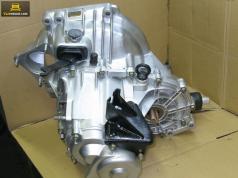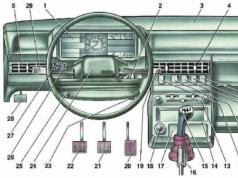Many car owners in the forums ask the question: "Why does oil in the engine smell like a gasoline?". The smell of most people belongs to the subjective category of sensations: for someone slightly gives gasoline, someone smells very much. The perception of smell intensity in each individual, and only specialists with the necessary equipment can make an objective assessment.
But also leave the fact that the engine oil smelled with gasoline, no attention should not be easily. Fuel entering the oil is possible only if there is a malfunction and can lead at least to the overruns of fuel and oil and as a maximum of the engine failure.
How to diagnose gasoline in the oil
The presence of gasoline in the engine lubricant fluid can be determined in a simple way. Property with a layer of oil is placed in a flame lighter or matches, while observing the precautions. It is better to do it in the fresh air, at a distance of 2-3 meters from the car. Oil without extraneous impurities is almost lit alone. If a certain proportion of gasoline is present in it, a bright flash will appear on the diploma.
If there is water or liquid in the oil or fluid from the cooling system, sparks, splashes and crackles are formed, as in sunflower oil in a skillet. If the test results will be gasoline in oil or liquid from the cooling system, it is worth remembering and evaluating the engine's behavior recently. The main criteria for the correct determination of the reason why there are gasoline in oil, are:
- increased fuel consumption;
- engine power: how rushes from the spot, gaining speed, as it pulls on the lines;
- foreign sound and knock in the piston unit;
- oil level in the engine pallet and its color;
- coolant level.
 To solve the problem of gasoline getting into the oil, a compressometer is used
To solve the problem of gasoline getting into the oil, a compressometer is used If there are any of these signs, it is advisable to contact specialists from the car service. If for any reason, the help of auto repair enterprises is excluded, you can try to understand yourself. The gasoline entering the oil is possible mainly due to malfunction of the mechanical fuel pump on carburetor engines, nozzles malfunction on injection engines and malfunction of the piston system on all types of engines. To work, you must have the following tools and devices:
- compressometer;
- pressure gauge with special fitting for measuring pressure in the fuel system;
- set of keys, screwdrivers, etc.;
- multimeter or similar measuring device;
- rags, liquid for removing dirt and flushing components;
- fluid for cutting the piston system (if necessary).
Check and repair mechanical fuel pump at home
Any repair work on the engine is desirable to start with washing and cleaning dirt and dust at least at the repair site. Fuel pump must be removed, unscrewing two fastening bolts. Supporting and outgoing benzins are better not to disconnect if they do not interfere with dismantling. Otherwise, they can be destroined by shutting them with a fit of the corresponding size with a plug, otherwise fuel flows out of it.
After removing the fuel pipelines, put on the fittings, fix the homutics. The exhaust benzing is necessary to press the clamp if it is rubber. If the tube is metallic, disconnect it from the carburetor and firmly shut a suitable plug. Then try pumping gasoline in the engine manual pumping lever. If on the side adjacent to the engine housing, gasoline flows will appear in oil or it will occur clearly and sharply released fuel smell, it means that the aperture of the fuel pump is not hermetic.
Further actions are possible for two options: replace the gas station to a similar new one or repair available. When repairing the already installed, you must purchase a repair kit for the device being repaired. As a temporary option, you can add a couple of cellophane layers into the diaphragm, but it is not for long. The disassembly and assembly of the benzonasos should be carried out in accordance with the guidance on the car.
In the presence of a set of spare parts for repair, it is desirable to replace all available parts, especially inlet and exhaust valves, their springs. The filtration mesh is thoroughly washed in pure gasoline or solvent. After the assembly, it is desirable to check for the performance of the device and the tightness of the diaphragm. Checking this part is described above.
It can be checked for working capacity by disconnecting the exhaust gasoline from the carburetor or pump and pumping it with the lever. From the hose or fitting, with each press, a complete jet of fuel should splash. After the end of all repair work, it takes some time during operation more carefully control the oil, its level and color for complete confidence that the problem is eliminated.
Faults and checking injector nozzles
If one or more injectors do not close completely, the fuel leak is possible into the cylinder and through the gaps in the piston into the oil. To begin with, you can check the pressure in the power system. To do this, you need to get a pressure gauge with a rubber hose for high pressure and adapter to connect to fuel ramp. The upper limit of the measured pressure manometer should be at least 6 kgf / cm².
Adapter must be connected to the ramp, pressure gauge - to the adapter. Then you need to turn on the ignition. If the fuel pump starts, wait until normal pressure rises in the ramp. Then the ignition should be turned off. If the fuel pump does not start when the ignition is turned on (this is not a malfunction), start the engine, check the pressure lift to nominal, drown out the engine and turn off the ignition.
For 5-10 minutes you need to observe the testimony of the pressure gauge. If the device's arrow shifted to the bottom side by more than a third (example: the nominal pressure was 3 kgf / cm², after the stop fell to 2 kgf / cm²), you should seek leakage in the fuel supply system. Next, it is necessary to remove the fuel ramp with nozzles and place it in an accessible place.  Not fully closed nozzles can cause fuel in lubrication
Not fully closed nozzles can cause fuel in lubrication
Each of the injectors should be placed in a transparent container, you can use plastic glasses with a volume of 0.5 liters. Petrol and electrical connections must be connected. Then it is also necessary to turn on the ignition, if necessary, scroll the engine starter.
During the scrolling, you can visually check the operation of the nozzles according to the type of sprayed fuel. By typing the optimal pressure in the power system, it is necessary to turn off the ignition and visually control each of the nozzles to the leakage of gasoline through the sprayer. Having found the leakage on one or more nozzles, you can measure the resistance of the windings with a tester.
If the measured resistance value differs from the nominal (usually 10-15 ohms), the nozzle leaks or the form of spraying torch differs from others, the nozzle must be replaced according to the guide to the car. After the end of the repair is also necessary for a certain period of operation to control the oil.
Fault of a piston system
This is one of the most expensive, complex and capacious fault labor costs in the car. When using poor-quality fuels and lubricants, it is possible to form a nagar on the pistons and the blocking of the piston rings. Simple language, this means that the grooves in which rings are located, clogged soot and the rings lost their elasticity. A clearance was formed between the walls of the cylinder and the piston, which "flies" a part of the incoming fuel.  Cleaning the piston system with special means
Cleaning the piston system with special means
The piston became a leakage. Determine such a defect is easy. Drivers with experience recommend twist the candle, plug the hole with a paper plug and turn the engine starter. If the plug crashes, it means that there are compression. This method is suitable only with the loss of a significant proportion of compression, gaps of grooves, damage to the piston. To determine the simple coking of its accuracy is not enough. For an error-free definition, you need to use the compressometer.
The device is a pressure gauge installed on a metal tube with a rubber tip and a check valve. More modern models are equipped with a rubber hose with a carving fitting, corresponding to the thread on the candlelight. Check you need to do together. On carburetor engines you need to unscrew all the candles. Connect the compressometer to one of the cylinders and rotate the engine starter until the arrow stops moving towards increasing the readings.
The resulting value will be a cylinder compression indicator. Then the operation should be repeated sequentially on all remaining cylinders. With the difference between the values \u200b\u200bobtained from the manufacturer installed by more than 10% or difference of readings between the cylinders, it is necessary to apply measures to troubleshoot. On cars with an injection system, you need to turn off the fuel pump before checking (pull the fuse).
Then you need to start the car and wait until it stalls, gasoline will end in the highway. After disconnecting the connector from the ignition system so that the high voltage does not damage the sensors. Further process is similar: unscrew the candles and consistently measure the compression in each of the cylinders. According to the results obtained, take action.
One of the simple ways to eliminate the engine to the use of special fluids.
The result from their use is not always unequivocal and can both eliminate the problem and aggravate it.
When using contamine liquids, it is necessary to strictly follow the instructions of the manufacturers and be sure to replace the oil after the end of the repair. If the use of cleaning fluids does not give effect or unacceptable, you should make the engine disassembly, get the pistons from the cylinders and repair them. This work is quite difficult to fulfill at home on your own. In such cases, it is better to contact the specialists from the car service.







